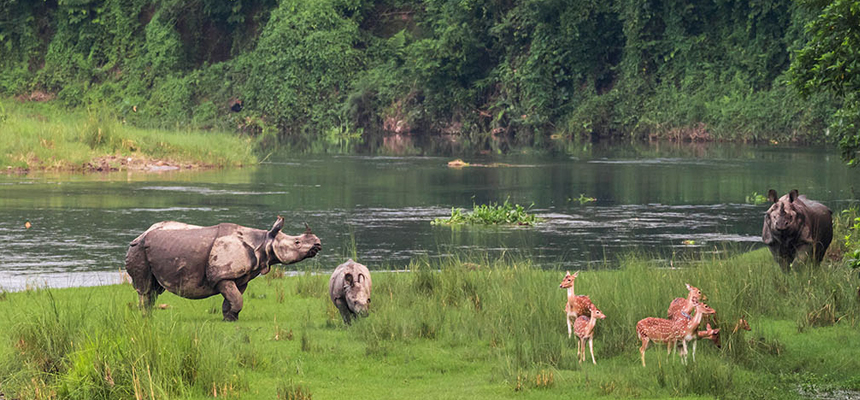Chitwan National Park is the first national park in Nepal. Formerly called Royal Chitwan National Park it was established in 1973 and granted the status of a World Heritage Site in 1984.Chitwan National Park stands as a successful testimony of nature conservation of South Asia. In 1950s, Chitwan’s forest and grasslands extended over more than 2600 sq. Km. and was home of about 800 rhinos.In the North and West of the protected area the Narayani – Rapti river system forms a natural boundary to human settlements. Adjacent to the east of Chitwan National Park is Parsha Wildlife Reserve, contiguous in the south is the Indian Tiger Reserve Valmiki National Park.
In 1996, an area of 750 sq. Km. surrounding the park was declared a buffer zone which consists of forests and private lands. The park and the local people jointly initiate community development activities and manage natural resources in the buffer zone. Government has made a provision of plowing back 30-50 percent of the park revenue for community development in the buffer zone.
The Chitwan valley consists of tropical and subtropical forests. Sal forests cover 70 percent of the park. Sal leaves are used locally for plates in festivals and religious offerings. Grasslands cover 20 percent of the park. There are more than 50 different types of grasses, including the elephant grass, renowned for its immense height. It can grow up to 8m in height. The park is home to more than 50 mammal species, over 525 birds, and 55 amphibians and reptiles. The endangered fauna found in the park are: One-horned rhinoceros, Gaur, Royal Bengal tiger, wild elephant, four horned antelope, Pangolin, Golden monitor lizard, Python, etc. Bengal florican, lesser florican, Giant hornbill, Black stork, While stork, etc.
For a country known for its beautiful mountains, the Gangetic flat lands of the Terai that stretches through out the southern part of Nepal provide a wholly different experience. A visit to Nepal remains incomplete without seeing the beauty of the Terai. Chitwan is the best place to do so. The Royal Chitwan National Park, established in 1973, provides a great wildlife experience with its rich flora and fauna . The wildlife and the landscape are not as breathtaking as those found in Africa but still, the experience will stand out.
Chitwan is only 150m. above the sea level. The place gets steamy from March-June, with peak temperatures reaching 43°C in the shade. Short grass makes February – May the best game-viewing season, but the autumn months are gorgeous, with Himalayan views, and in winter (December-January), Chitwan is pleasantly warmed compared to Kathmandu. The monsoon season (July-August) is intense, with pounding rain, swollen rivers, and luxuriant vegetation. While the rain isn’t constant, the humidity is all pervasive.
Though one can visit neighboring Tharu villages in Chitwan, the major interesting focus of Chitwan is still the exploration of the Chitwan National Park.
Flora and Fauna
The flora and fauna of Chitwan makes it a great place for nature lovers. Chitwan has over 50 different species of mammals, 400 different species of birds, and 65 different types of butterflies in its hardwood Sal forests, riverine vegetation, and “elephant grass” savannah. More than 70 different species of grass grow here.
The most famous wildlife in Chitwan is perhaps the single-horned Asian rhinoceros. A few decades ago, their number had fallen to less than 100, but recent count puts them at 400. These animals have thick armor like hide that is hard to penetrate even with a bullet.
A fully grown animal can be as tall as 180cm. In spite of army protection for these animals and severe punishment for harming them, rhino poaching is still a problem as every organ of the animal carries some (probably superstitious) value. The horn fetches about US$10,000 per kilo and is believed to be an aphrodisiac. The dung can be a laxative, the urine cures tuberculosis and asthma. The blood can help cure menstrual problems. The hide keeps away evil spirits. And so on.
Chitwan has about 150 Bengal tigers left of the one time 3000 or so. Though poaching is a serious threat, the real threat for these majestic animals is the gradual loss of its habitat. A male tiger requires almost 60 Km. space, and a female one requires a third of it. Chitwan is simply not big enough to handle many tigers. It is rare for one to actually see a tiger, though looking for one is an interesting part of the trip.Other wild mammals one can see are leopards, various types of deer, monkeys, sloth bear, and antelope.


Comments